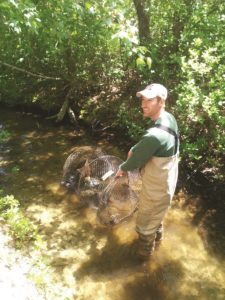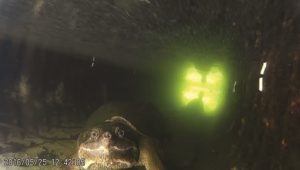WELLFLEET — In the summer, alewives and bluebacks — two species of herring that in spring migrate from the coastal marshes here to the Herring River’s kettle ponds — stay in the ponds to forage and feed until fall. As temperatures drop, these juvenile herring swim downstream, leaving their freshwater spawning grounds for the sea. There, they spend several years growing into adults. Each spring, mature herring face a daunting task: pulling a U-turn and pushing their way back up the Herring River to spawn the next generation.
Their journey back home is perilous, particularly at two chokepoints created by manmade structures. Understanding how these obstacles affect the herring has given scientists an up-close view of changes to come once the river’s natural tidal flow is restored.
First, at the river’s mouth, looms the Chequessett Neck Road dike, erected in 1908 to dry up the “unsightly swamps” upstream for mosquito control, according to a 1906 proposal by Whitman and Howard Engineers. (As previously reported here, current science shows the effect was the opposite as far as mosquito control goes.) The dike functions as a tide gate, allowing river outflow but blocking inflow from the bay.
Further up the Herring River, the migrating fish must travel through a culvert — a pipe that shunts the stream beneath Schoolhouse Hill Road.
Both chokepoints have created what aquatic ecologist Derrick Alcott called “a feeding tube for predators.” Up and down the river, herring casualties result — just outside the dike, where hungry striped bass patrol, and in the culvert, where snapping turtles hunker.
The Toll at the Tide Gate
We know this because Alcott tagged and tracked the herring as part of his Ph.D. research at UMass Amherst. Though the research was conducted in the mid-2000s, his conclusions were only recently published in a 2021 article in the Canadian Journal of Fishing and Aquatic Sciences.

Alcott said the tagging involved teams of two, working at lightning speed. One person holds down the writhing fish, securing its head and tail. A colleague angles a scalpel toward the fish’s belly. A quick poke between the ribs and pelvis — and in goes the passive integrated transponder (PIT) tag, where it lies loose in the stomach cavity, nestled among internal organs. Surgical glue helps seal the incision, then the herring is released back into the waves. For each fish, the whole process — capture, measurement, tagging, release — happens in under a minute.
Researchers working with other animals would typically administer anesthesia for this surgery, but herring, being “ram ventilators,” need to keep swimming forward in order to move dissolved oxygen over their gills. Anesthesia would halt the fish’s movement — which, in turn, would rob them of air. “We determined the safest method for these fish is to not anesthetize, go super fast, and get them back into the water, swimming and breathing,” said Alcott.
After placing a detection antenna at the dike, Alcott and his colleagues watched the run for two spring seasons in 2014 and 2015. The setup functioned like an EZ-pass system. Each time a PIT-tagged fish swam through, the device recorded the date and time along with a code unique to each specimen.
Their findings were troubling. Many herring, despite multiple attempts, failed to pass through the tide gate at the dike, which “acted as an obstacle to upstream migration,” Alcott and his colleagues reported. Their work confirmed “long-held local suspicions,” according to John Portnoy, a retired National Seashore ecologist.
For decades, local observers had worried that the tidal restriction at the dike was harming the herring run. Portnoy voiced his own concerns over the dike in a 1997 article published in Environment Cape Cod. Wellfleet’s river herring fishery was “once one of the largest in the state,” he told the Independent. Before the dike was built, the town annually collected $1,000 from the herring auction, which was “enough to pay all the town’s elected officials,” Portnoy wrote after reviewing old town meeting records. But after the dike was constructed, earnings plunged, along with Wellfleet’s herring run.
While Alcott’s study anchored these observations, the PIT-tag data surfaced new questions.
Herring in a Pickle
Early in the spawning run season, 78 percent of tagged herring passed through the dike, but near the end of the period, the success rate sank to 16 percent.
Alcott then co-authored a new Wellfleet-based study, this one with Christopher Rillahan at the UMass Dartmouth School for Marine Science and Technology, that zeroed in on a likely culprit: striped bass — which, thanks to conditions created by the dike, can feast on a fish-in-a-barrel buffet when these later herring waves come.
This time, Rillahan deployed a new technology — the ARIS Explorer 3000 — to visualize the action churning just seaward of the dike. With ARIS, he was spared the rigors of performing dozens of 60-second surgeries. His device allowed him to monitor fish noninvasively by emitting a series of sonar beams underwater. ARIS then converts these sonar readings into fine-scale videos, which showed the silhouette images of herring milling around, migrating, and, when stripers arrived, scattering.

The stripers caught on the ARIS videos look like larger shadows, swimming solo or in loose aggregations. The smaller herring, by contrast, stay in tight schools.
The dike channels large volumes of water through a narrow opening — a setup akin to partially blocking a garden hose with your thumb. So, it “dumps out water in a huge jet of turbulent, high-velocity water,” said Alcott.
The herring can ride an incoming tide up the river, but when the tide recedes, billowing back towards the harbor, “those conditions are just too powerful for a fish to swim against,” Alcott said. For slightly more than half of the day, the dike is completely impassable.
Meanwhile, the water jets have carved out deep scour pools on both sides of the dike. During the impenetrable outflow periods, herring gather in those pools, waiting for the water to change direction. The problem for the herring, said Alcott, is that “predators may be there, waiting.”
And, in fact, the ARIS Explorer 3000 caught footage of large numbers of striped bass joining the herring there, particularly during the ebbing tide. This dike, the researchers proposed, spared predators the chase, where “prey win the race a bunch of times and get away,” Alcott said. Instead, the striped bass “can just hang” and get an easy shot at the herring.
“It’s no surprise that the area seaward of the dike is a great fishing spot,” said Barbara Brennessel, a Wellfleet biologist not involved in the research. “Every time you drive there, except at low tide, you will see fishermen parked on the dike, poles in the water.
“The river herring are captives, having to wait for ideal conditions to pass the tide gates,” she added, “and when the stripers and bluefish arrive, they are toast.”
Out of the Frying Pan
For the herring that manage to dodge the stripers, wriggle through the dike, and continue up their namesake river, it’s far from smooth sailing.
In the upper reaches of the river, Patience Brook splinters off from the main trunk, flowing as a narrow, ankle-deep stream that feeds into the ponds. At Schoolhouse Hill Road, the water enters a culvert — a ribbed-steel pipe about two feet in diameter — which shunts the brook underneath the road to emerge on the other side. Putting in a culvert is cheaper than building a bridge to take the road over the river.

Come springtime, herring migrate through Patience Brook and into the culvert, where they are met with a snapping turtle ambush.
Once again, local observers already had an idea what was happening. On several occasions, volunteer herring counters had witnessed snapping turtles crawling into that culvert. “People sat there and waited for them to come out on the other side,” Alcott said, “but they didn’t.” Instead, folks told him they’ve heard popping sounds from below — the snap of a turtle’s jaws, perhaps, clamping down on a herring snack.
To follow up on these reports, Alcott set up further research using underwater cameras. Sure enough, snappers were posting up in the culvert, taking up the full width and lunging at incoming herring. Alcott logged further evidence by drawing blood samples from the turtles. “You are what you eat,” Alcott said, “so your blood will contain the carbon atoms of the things you’re eating.”
Turtles that ventured into the culvert exhibited high levels of marine-derived carbon isotopes in their blood, while those who stayed away showed no signs of these atoms.
“As for the herring, they often swim through the culvert, right through the center — whether there’s a turtle or not,” Alcott said. “They don’t seem to recognize the snapping turtle as a threat.”
By contrast, bass, perch, and sunfish swerve out of the snapper’s way. Alcott is not sure why this is so. It could be, he guesses, a lack of familiarity with the trap. Or it could be the herring’s “deep, innate urge to move upstream in order to spawn and produce the next generation.”
Alcott imagines a herring’s risk analysis, if there were such a thing, unfolding differently at the culvert than it would at the tide gate. “Think about the costs and benefits,” Alcott said. “Once you’ve migrated all the way up the river, it’s like, ‘Well, I have no choice now. I’ve invested so much in this.’ ”
At the tide gate, by comparison, Alcott continued, “If it looks like a nightmare with the stripers and you’re running a predator gauntlet, then it’s like, ‘Eh, maybe we’ll check out a different river.’ ”
The good news at the culvert: turtles consume less than one percent of the herring population, according to Alcott.
“The tide gate is the bigger problem,” he said. Of the fish trying to clear the Chequessett Neck dike, only 50 percent make it through, enter the river, and migrate upstream to spawn.
When the Herring River Restoration Project opens up the dike, Alcott predicts, herring will have passable conditions all day every day. The stripers, at that point, will presumably have to sing for their supper.



